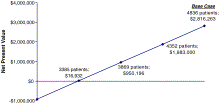Operational and financial impact of physician screening in the ED☆☆☆
Affiliations
- Department of Emergency Medicine, University of Pennsylvania, Philadelphia, PA, USA
Correspondence
- Corresponding author. Tel.: +1 646 8314970.

Affiliations
- Department of Emergency Medicine, University of Pennsylvania, Philadelphia, PA, USA
Correspondence
- Corresponding author. Tel.: +1 646 8314970.
Affiliations
- Division of Emergency Medicine, Harvard Medical School, Boston, MA, USA
- Department of Emergency Medicine, Massachusetts General Hospital, Boston, MA, USA
Affiliations
- Division of Emergency Medicine, Harvard Medical School, Boston, MA, USA
- Department of Emergency Medicine, Massachusetts General Hospital, Boston, MA, USA
Affiliations
- Department of Emergency Medicine, Massachusetts General Hospital, Boston, MA, USA
Affiliations
- Department of Medicine, Massachusetts General Hospital, Boston, MA, USA
Affiliations
- Department of Emergency Medicine, Massachusetts General Hospital, Boston, MA, USA
Affiliations
- Division of Emergency Medicine, Harvard Medical School, Boston, MA, USA
- Department of Emergency Medicine, Massachusetts General Hospital, Boston, MA, USA
 Article Info
Article Info
To view the full text, please login as a subscribed user or purchase a subscription. Click here to view the full text on ScienceDirect.

Fig. 1
ED patient flow.

Fig. 2
Sensitivity analysis: impact of incremental capacity on NPV.
Abstract
Background
Physician screening is one of many front-end interventions being implemented to improve emergency department (ED) efficiency.
Study objective
We aimed to quantify the operational and financial impact of this intervention at an urban tertiary academic center.
Methods
We conducted a 2-year before-after analysis of a physician screening system at an urban tertiary academic center with 90 000 annual visits. Financial impact consisted of the ED and inpatient revenue generated from the incremental capacity and the reduction in left without being seen (LWBS) rates. The ED and inpatient margin contribution as well as capital expenditure were based on available published data. We summarized the financial impact using net present value of future cash flows performing sensitivity analysis on the assumptions. Operational outcome measures were ED length of stay and percentage of LWBS.
Results
During the first year, we estimate the contribution margin of the screening system to be $2.71 million and the incremental operational cost to be $1.86 million. Estimated capital expenditure for the system was $1 200 000. The NPV of this investment was $2.82 million, and time to break even from the initial investment was 13 months. Operationally, despite a 16.7% increase in patient volume and no decrease in boarding hours, there was a 7.4% decrease in ED length of stay and a reduction in LWBS from 3.3% to 1.8%.
Conclusions
In addition to improving operational measures, the implementation of a physician screening program in the ED allowed for an incremental increase in patient care capacity leading to an overall positive financial impact.
To access this article, please choose from the options below
Purchase access to this article
Claim Access
If you are a current subscriber with Society Membership or an Account Number, claim your access now.
Subscribe to this title
Purchase a subscription to gain access to this and all other articles in this journal.
Institutional Access
Visit ScienceDirect to see if you have access via your institution.
Related Articles
Searching for related articles..


